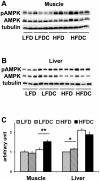Insights into the molecular mechanisms of the anti-atherogenic actions of flavonoids in normal and obese mice
- PMID: 22016761
- PMCID: PMC3189911
- DOI: 10.1371/journal.pone.0024634
Insights into the molecular mechanisms of the anti-atherogenic actions of flavonoids in normal and obese mice
Abstract
Obesity is a major and independent risk factor for cardiovascular disease and it is strongly associated with the development of dyslipidemia, insulin resistance and type 2 diabetes. Flavonoids, a diverse group of polyphenol compounds of plant origin widely distributed in human diet, have been reported to have numerous health benefits, although the mechanisms underlying these effects have remained obscure. We analyzed the effects of chronic dietary supplementation with flavonoids extracted from cranberry (FLS) in normal and obese C57/BL6 mice compared to mice maintained on the same diets lacking FLS. Obese mice supplemented with flavonoids showed an amelioration of insulin resistance and plasma lipid profile, and a reduction of visceral fat mass. We provide evidence that the adiponectin-AMPK pathway is the main mediator of the improvement of these metabolic disorders. In contrast, the reduced plasma atherogenic cholesterol observed in normal mice under FLS seems to be due to a downregulation of the hepatic cholesterol synthesis pathway. Overall, we demonstrate for the first time that the molecular mechanisms underlying the beneficial effects of flavonoids are determined by the metabolic state.
Conflict of interest statement
Figures







Similar articles
-
Tiliroside, a glycosidic flavonoid, ameliorates obesity-induced metabolic disorders via activation of adiponectin signaling followed by enhancement of fatty acid oxidation in liver and skeletal muscle in obese-diabetic mice.J Nutr Biochem. 2012 Jul;23(7):768-76. doi: 10.1016/j.jnutbio.2011.04.001. Epub 2011 Sep 1. J Nutr Biochem. 2012. PMID: 21889885
-
Immature Citrus sunki peel extract exhibits antiobesity effects by β-oxidation and lipolysis in high-fat diet-induced obese mice.Biol Pharm Bull. 2012;35(2):223-30. doi: 10.1248/bpb.35.223. Biol Pharm Bull. 2012. PMID: 22293353
-
Ganoderma lucidum Extract Reduces Insulin Resistance by Enhancing AMPK Activation in High-Fat Diet-Induced Obese Mice.Nutrients. 2020 Oct 30;12(11):3338. doi: 10.3390/nu12113338. Nutrients. 2020. PMID: 33142995 Free PMC article.
-
Metabolic Impact of Flavonoids Consumption in Obesity: From Central to Peripheral.Nutrients. 2020 Aug 10;12(8):2393. doi: 10.3390/nu12082393. Nutrients. 2020. PMID: 32785059 Free PMC article. Review.
-
Dietary Flavonoids and Insulin Signaling in Diabetes and Obesity.Cells. 2021 Jun 11;10(6):1474. doi: 10.3390/cells10061474. Cells. 2021. PMID: 34208379 Free PMC article. Review.
Cited by
-
Evaluation of In Vitro Antioxidant and Antidiabetic Activities of Aristolochia longa Extracts.Evid Based Complement Alternat Med. 2019 Apr 2;2019:7384735. doi: 10.1155/2019/7384735. eCollection 2019. Evid Based Complement Alternat Med. 2019. PMID: 31061671 Free PMC article.
-
The American cranberry: first insights into the whole genome of a species adapted to bog habitat.BMC Plant Biol. 2014 Jun 13;14:165. doi: 10.1186/1471-2229-14-165. BMC Plant Biol. 2014. PMID: 24927653 Free PMC article.
-
Contrasting a reference cranberry genome to a crop wild relative provides insights into adaptation, domestication, and breeding.PLoS One. 2022 Mar 7;17(3):e0264966. doi: 10.1371/journal.pone.0264966. eCollection 2022. PLoS One. 2022. PMID: 35255111 Free PMC article.
-
In Vitro Inhibition of α-Amylase and α-Glucosidase by Extracts from Psiadia punctulata and Meriandra bengalensis.Evid Based Complement Alternat Med. 2018 Jul 16;2018:2164345. doi: 10.1155/2018/2164345. eCollection 2018. Evid Based Complement Alternat Med. 2018. PMID: 30108648 Free PMC article.
-
The first genetic map of the American cranberry: exploration of synteny conservation and quantitative trait loci.Theor Appl Genet. 2013 Mar;126(3):673-92. doi: 10.1007/s00122-012-2010-8. Epub 2012 Dec 8. Theor Appl Genet. 2013. PMID: 23224333
References
-
- Barnes S, Prasain J. Current progress in the use of traditional medicines and nutraceuticals. Curr Opin Plant Biol. 2005;8:324–328. - PubMed
-
- Liu RH. Health benefits of fruit and vegetables are from additive and synergistic combinations of phytochemicals. Am J Clin Nutr. 2003;78:517S–520S. - PubMed
-
- Williams RJ, Spencer JP, Rice-Evans C. Flavonoids: antioxidants or signalling molecules? Free Radic Biol Med. 2004;36:838–849. - PubMed
-
- Pappas E, Schaich KM. Phytochemicals of cranberries and cranberry products: characterization, potential health effects, and processing stability. Crit Rev Food Sci Nutr. 2009;49:741–781. - PubMed
-
- Masella R, Di Benedetto R, Vari R, Filesi C, Giovannini C. Novel mechanisms of natural antioxidant compounds in biological systems: involvement of glutathione and glutathione-related enzymes. J Nutr Biochem. 2005;16:577–586. - PubMed
Publication types
MeSH terms
Substances
LinkOut - more resources
Full Text Sources
Medical

